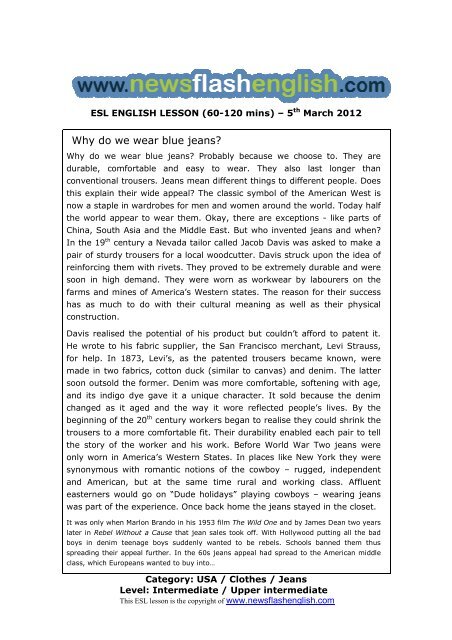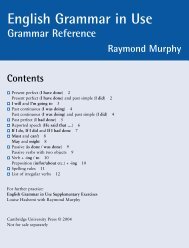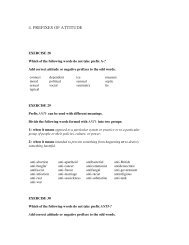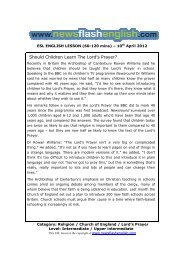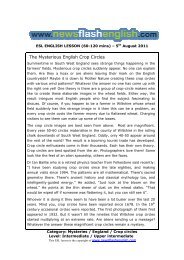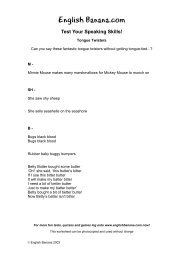Why do we wear blue jeans? - ESL Teachers Board
Why do we wear blue jeans? - ESL Teachers Board
Why do we wear blue jeans? - ESL Teachers Board
- No tags were found...
You also want an ePaper? Increase the reach of your titles
YUMPU automatically turns print PDFs into web optimized ePapers that Google loves.
EXERCISES<strong>Why</strong> <strong>do</strong> <strong>we</strong> <strong>we</strong>ar <strong>blue</strong> <strong>jeans</strong>? – 5 th March 20121. Blue <strong>jeans</strong>: Think of three things you know about <strong>blue</strong> <strong>jeans</strong>. Go round theroom swapping details with others.2. Dictation: The teacher will read four to six lines of the article slowly andclearly. Students will write <strong>do</strong>wn what they hear. The teacher will repeat the passageslowly again. Self-correct your work from page one - filling in spaces and correctingmistakes. Be honest with yourself on the number of errors. Advise the teacher ofyour total number of errors. Less than five is very good. Ten is acceptable. Any moreis room for improvement! More than t<strong>we</strong>nty - you need to <strong>do</strong> some work!3. Reading: The students should now read the article aloud, swapping readersevery paragraph.4. Vocabulary: Students should now look through the article and underline anyvocabulary they <strong>do</strong> not know. Look in dictionaries. Discuss and help each other out.The teacher will go through and explain any unknown words or phrases.5. The article: Students should look through the article with the teacher.a) What is the article about?b) What <strong>do</strong> you think about the article?6. Jeans: In pairs think of five things from the article about <strong>blue</strong> <strong>jeans</strong>. Then addfive thoughts of your own. Write them below. Discuss together.From the articleYour own information1 12 23 34 45 5The teacher will choose some pairs to discuss their findings in front of the class.7. Let’s roleplay 1: KMKT Dallas: In pairs/groups. One of you is theintervie<strong>we</strong>r. The others are one of the following people. You are in the KMKT FMradio studio in Dallas, USA. Today’s interview is about: <strong>Why</strong> <strong>do</strong> <strong>we</strong> <strong>we</strong>ar <strong>blue</strong> <strong>jeans</strong>?1 A cowboy2 A tourist who has visited a Dude ranch3 Levi Strauss spokesperson4 Great, Great Grandson of Jacob DavisThe teacher will choose some pairs to roleplay their interview in front of the class.8. Let’s think! In pairs. On the board write as many words as you can to <strong>do</strong>with Blue <strong>jeans</strong>. One-two minutes. Compare with other teams. Using your wordscompile a short dialogue together.Find this and similar lessons at http://www.NewsFlashEnglish.com2
DISCUSSION<strong>Why</strong> <strong>do</strong> <strong>we</strong> <strong>we</strong>ar <strong>blue</strong> <strong>jeans</strong>? – 5 th March 2012Student A questions1) Did the headline make you want to read the article?2) Do you <strong>we</strong>ar <strong>jeans</strong>? Explain!3) <strong>Why</strong> are <strong>jeans</strong> so popular?4) How many students are <strong>we</strong>aring <strong>jeans</strong> today in the class?5) Would you like to go to Texas?6) Do cowboys still <strong>we</strong>ar <strong>jeans</strong>?7) When <strong>we</strong>re <strong>jeans</strong> introduced in your country?8) Can <strong>jeans</strong> be worn on any occasion?9) <strong>Why</strong> <strong>do</strong> you think <strong>jeans</strong> <strong>we</strong>re popular during the 1950s in America?10) What made <strong>jeans</strong> fashionable for women to <strong>we</strong>ar?Student B questions1) What <strong>do</strong> you think about what you read?2) Have you learnt anything in today’s English lesson?3) What colour <strong>jeans</strong> <strong>do</strong> you <strong>we</strong>ar?4) Would you like to go on a Dude holiday?5) When <strong>do</strong> you <strong>we</strong>ar <strong>jeans</strong>?6) How <strong>do</strong> you think World War Two influenced people <strong>we</strong>aring <strong>jeans</strong>?7) What type of <strong>jeans</strong> might rockabillies, hippies, and punks worn?8) <strong>Why</strong> <strong>we</strong>re Bran<strong>do</strong> and Dean so important for <strong>jeans</strong>?9) How might <strong>blue</strong> jean sales have been affected by the American Vietnamwar draft or the racial discrimination in America during the 1960s?10) Did you like this discussion?SPEAKINGLet’s discuss! Blue <strong>jeans</strong>Allow 10-15 minutes – As a class / small groups / pairs / 1 to 120 things about <strong>blue</strong> <strong>jeans</strong>The teacher can moderate the session.Find this and similar lessons at http://www.NewsFlashEnglish.com4
<strong>Why</strong> <strong>do</strong> <strong>we</strong> <strong>we</strong>ar <strong>blue</strong> <strong>jeans</strong>? – 5 th March 2012GAP FILL: READING:Put the words into the gaps in the text.<strong>Why</strong> <strong>do</strong> <strong>we</strong> <strong>we</strong>ar <strong>blue</strong> <strong>jeans</strong>?<strong>Why</strong> <strong>do</strong> <strong>we</strong> <strong>we</strong>ar <strong>blue</strong> <strong>jeans</strong>? Probably because <strong>we</strong> choose to.They are (1)_____, comfortable and easy to <strong>we</strong>ar. They also lastlonger than conventional trousers. (2)_____ mean differentthings to different people. Does this explain their wide appeal?The classic (3)_____ of the American West is now a staple inwardrobes for men and women around the world. Today half theworld appear to <strong>we</strong>ar them. Okay, there are (4)_____ - like partsof China, South Asia and the Middle East. But who invented <strong>jeans</strong>and when? In the 19 th century a Nevada (5)_____ called JacobDavis was asked to make a pair of (6)_____ trousers for a local(7)_____. Davis struck upon the idea of reinforcing them withrivets. They proved to be extremely durable and <strong>we</strong>re soon inhigh demand. They <strong>we</strong>re worn as work<strong>we</strong>ar by labourers on thefarms and mines of America’s Western states. The reason fortheir (8)_____ has as much to <strong>do</strong> with their cultural meaning as<strong>we</strong>ll as their physical construction.tailorsymboldurablesuccess<strong>jeans</strong>woodcuttersturdyexceptionsDavis realised the potential of his product but couldn’t afford topatent it. He wrote to his fabric (1)_____, the San Franciscomerchant, Levi Strauss, for help. In 1873, Levi’s, as the patented(2)_____ became known, <strong>we</strong>re made in two fabrics, cotton duck(similar to canvas) and denim. The latter soon outsold theformer. Denim was more comfortable, softening with age, and itsindigo dye gave it a unique character. It sold because the(3)_____ changed as it aged and the way it wore reflectedpeople’s lives. By the beginning of the 20 th century workersbegan to realise they could (4)_____ the trousers to a morecomfortable (5)_____. Their (6)_____ enabled each pair to tellthe story of the worker and his work. Before World War Two<strong>jeans</strong> <strong>we</strong>re only worn in America’s Western States. In places likeNew York they <strong>we</strong>re synonymous with romantic notions of the(7)_____ – rugged, independent and American, but at the sametime rural and working class. Affluent easterners would go on“Dude holidays” playing cowboys – <strong>we</strong>aring <strong>jeans</strong> was part of theexperience. Once back home the <strong>jeans</strong> stayed in the (8)_____.closetdurabilitydenimsuppliertrouserscowboyfitshrink5Find this and similar lessons at http://www.NewsFlashEnglish.com
<strong>Why</strong> <strong>do</strong> <strong>we</strong> <strong>we</strong>ar <strong>blue</strong> <strong>jeans</strong>? – 5 th March 2012GAP FILL: LISTENINGListen and fill in the spaces.<strong>Why</strong> <strong>do</strong> <strong>we</strong> <strong>we</strong>ar <strong>blue</strong> <strong>jeans</strong>?<strong>Why</strong> ________________? Probably because <strong>we</strong> choose to. They aredurable, comfortable ________________. They also last longer thanconventional trousers. Jeans mean different things to different people. Doesthis explain their wide appeal? The _____________________ AmericanWest is now a staple in wardrobes for men and women around the world.Today half the world appear to <strong>we</strong>ar them. Okay, ____________________- like parts of China, South Asia and the Middle East. But who invented<strong>jeans</strong> and when? In the 19 th century a Nevada tailor called Jacob Davis wasasked to make a pair of sturdy trousers ______________________. Davisstruck upon the idea of reinforcing them with rivets. They proved to beextremely durable and <strong>we</strong>re soon in high demand. They <strong>we</strong>re worn aswork<strong>we</strong>ar by labourers on the farms and mines of America’s Western states.The reason for their success has as much to <strong>do</strong> with their cultural meaningas <strong>we</strong>ll as their _____________________.Davis realised the potential of his product but couldn’t afford to patent it.He wrote ______________________, the San Francisco merchant, LeviStrauss, for help. In 1873, Levi’s, as the patented trousers became known,<strong>we</strong>re made in two fabrics, cotton duck (_________________) and denim.The latter soon outsold the former. Denim was more comfortable, softeningwith age, and its indigo dye gave it __________________. It sold becausethe denim changed as it aged and the way it wore reflected people’s lives.By the beginning of the 20 th century workers began to realise_____________________ trousers to a more comfortable fit. Theirdurability enabled each pair to tell the story of the worker and his work.Before World War Two <strong>jeans</strong> <strong>we</strong>re only worn in America’s Western States.In places like New York they <strong>we</strong>re synonymous with romantic notions of thecowboy – rugged, independent and American, ____________________rural and working class. Affluent easterners would go on “Dude holidays”playing cowboys – <strong>we</strong>aring <strong>jeans</strong> was part of the experience. Once backhome the <strong>jeans</strong> ____________________.6Find this and similar lessons at http://www.NewsFlashEnglish.com
GRAMMAR:<strong>Why</strong> <strong>do</strong> <strong>we</strong> <strong>we</strong>ar <strong>blue</strong> <strong>jeans</strong>? – 5 th March 2012Put the words into the gaps in the text.<strong>Why</strong> <strong>do</strong> <strong>we</strong> <strong>we</strong>ar <strong>blue</strong> <strong>jeans</strong>?<strong>Why</strong> <strong>do</strong> <strong>we</strong> <strong>we</strong>ar <strong>blue</strong> <strong>jeans</strong>? Probably because <strong>we</strong> choose to.They are durable, comfortable and easy to <strong>we</strong>ar. They (1)__ lastlonger (2)__ conventional trousers. Jeans mean different thingsto different people. Does (3)__ explain their wide appeal? Theclassic symbol of the American West is now a staple in wardrobesfor men and women around the world. Today half the worldappear to <strong>we</strong>ar them. Okay, (4)__ are exceptions - like parts ofChina, South Asia and the Middle East. But who invented <strong>jeans</strong>and when? In the 19 th century a Nevada tailor called Jacob Daviswas asked to make a pair of sturdy trousers for a localwoodcutter. Davis struck upon the idea of reinforcing (5)__ withrivets. (6)__ proved to be extremely durable and <strong>we</strong>re soon inhigh demand. They <strong>we</strong>re worn as work<strong>we</strong>ar by labourers on thefarms and mines of America’s Western states. The reason for theirsuccess has as much to <strong>do</strong> (7)__ their cultural meaning as <strong>we</strong>ll as(8)__ physical construction.withthemthisalsotherethantheirtheyDavis realised (1)__ potential of his product (2)__ couldn’t affordto patent it. He wrote to (3)__ fabric supplier, the San Franciscomerchant, Levi Strauss, (4)__ help. In 1873, Levi’s, as thepatented trousers became known, <strong>we</strong>re made in two fabrics,cotton duck (similar to canvas) (5)__ denim. The latter soonoutsold the former. Denim was more comfortable, softening withage, and (6)__ indigo dye gave it a unique character. It soldbecause the denim changed as it aged and the way it worereflected people’s lives. By the beginning of the 20 th centuryworkers began to realise they could shrink the trousers to a morecomfortable fit. Their durability enabled each pair to tell the storyof the worker and his work. Before World War Two <strong>jeans</strong> <strong>we</strong>reonly worn in America’s Western States. (7)__ places like NewYork they <strong>we</strong>re synonymous with romantic notions of the cowboy– rugged, independent and American, but at the same time ruraland working class. Affluent easterners would go on “Dudeholidays” playing cowboys – <strong>we</strong>aring <strong>jeans</strong> was part (8)__ theexperience. Once back home the <strong>jeans</strong> stayed in the closet.ofinforbutitshisandthe7Find this and similar lessons at http://www.NewsFlashEnglish.com
SPELLING TEST<strong>Why</strong> <strong>do</strong> <strong>we</strong> <strong>we</strong>ar <strong>blue</strong> <strong>jeans</strong>? – 5 th March 2012The teacher will ask the class individually to spell the following words that are in thearticle. Afterwards, check your ans<strong>we</strong>rs with your teacher, using the followingratings: Pass = 12, Good = 15, Very good = 18, Excellent = 201 extremely 11 canvas2 comfortable 12 labourers3 conventional 13 potential4 trousers 14 cowboy5 <strong>jeans</strong> 15 woodcutter6 wardrobes 16 probably7 symbol 17 latter8 unique 18 sturdy9 durability 19 tailor10 shrink 20 rivetsLINKShttp://www.931kmkt.com/http://www.bbc.co.uk/news/magazine-17101768http://en.wikipedia.org/wiki/Jeanshttp://www.<strong>jeans</strong>.com/Note: sturdy = hardy, muscular, brawny, stout, strong, po<strong>we</strong>rful.ANSWERSGAP FILL: <strong>Why</strong> <strong>do</strong> <strong>we</strong> <strong>we</strong>ar <strong>blue</strong> <strong>jeans</strong>? <strong>Why</strong> <strong>do</strong> <strong>we</strong> <strong>we</strong>ar <strong>blue</strong> <strong>jeans</strong>? Probably because <strong>we</strong>choose to. They are durable, comfortable and easy to <strong>we</strong>ar. They also last longer than conventionaltrousers. Jeans mean different things to different people. Does this explain their wide appeal? Theclassic symbol of the American West is now a staple in wardrobes for men and women around theworld. Today half the world appear to <strong>we</strong>ar them. Okay, there are exceptions - like parts of China,South Asia and the Middle East. But who invented <strong>jeans</strong> and when? In the 19 th century a Nevada tailorcalled Jacob Davis was asked to make a pair of sturdy trousers for a local woodcutter. Davis struckupon the idea of reinforcing them with rivets. They proved to be extremely durable and <strong>we</strong>re soon inhigh demand. They <strong>we</strong>re worn as work<strong>we</strong>ar by labourers on the farms and mines of America’s Westernstates. The reason for their success has as much to <strong>do</strong> with their cultural meaning as <strong>we</strong>ll as theirphysical construction.Davis realised the potential of his product but couldn’t afford to patent it. He wrote to his fabricsupplier, the San Francisco merchant, Levi Strauss, for help. In 1873, Levi’s, as the patentedtrousers became known, <strong>we</strong>re made in two fabrics, cotton duck (similar to canvas) and denim. Thelatter soon outsold the former. Denim was more comfortable, softening with age, and its indigo dyegave it a unique character. It sold because the denim changed as it aged and the way it worereflected people’s lives. By the beginning of the 20 th century workers began to realise they couldshrink the trousers to a more comfortable fit. Their durability enabled each pair to tell the story ofthe worker and his work. Before World War Two <strong>jeans</strong> <strong>we</strong>re only worn in America’s Western States. Inplaces like New York they <strong>we</strong>re synonymous with romantic notions of the cowboy – rugged,independent and American, but at the same time rural and working class. Affluent easterners would goon “Dude holidays” playing cowboys – <strong>we</strong>aring <strong>jeans</strong> was part of the experience. Once back home the<strong>jeans</strong> stayed in the closet. (V2)Created by David Robinson. This <strong>ESL</strong> lesson is the copyright of www.newsflashenglish.comFind this and similar lessons at http://www.NewsFlashEnglish.com8


